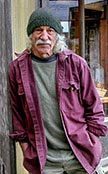 Artist/architect John Connell designed and built this house in a played-out gravel pit near Warren, Vermont. It was built over 16 years with input from about 65 students from John’s six-week Deign/Build sessions at Yestermorrow School in Warren, Vermont.
Artist/architect John Connell designed and built this house in a played-out gravel pit near Warren, Vermont. It was built over 16 years with input from about 65 students from John’s six-week Deign/Build sessions at Yestermorrow School in Warren, Vermont.
John: “The idea was to show that intelligent land development could actually help repair land as opposed to its usual role in degrading it. I purchased this played-out gravel pit which was then subdivided into four lots with a common area. In the common area we built Vermont’s first licensed engineered wetland specifically designed to treat waste. It was sized to accommodate four 3-bedroom homes. This house was the first to be built (proof of concept). Sadly, the people who purchased the house also purchased the remaining lots and closed down the project. So we successfully refurbished the gravel pit (maybe a bit too well) but failed to create the neighborhood we had hoped for. Had we sold the lots separately, it would have become this fabulous little neighborhood of four hi-performance homes and a green house on ten acres along the Mad River. That was the vision.
As it was designed and built (over those 16 years), that house was meant to reflect the very latest in sustainable thinking. It is super insulated, is heated by less than 500 gallons of propane each winter with a super hi-eff boiler (93%+), the wood was mostly local, the materials were recycled whenever possible, non-toxic glues and sealers were used (after 1991), etc. etc.”


Highlights the importance of including the social and economic aspects, not just building & infrastucture, if you aim for sustainability.
Great looking- and been meaning to check out this school- and hopefully film them for an episode of "Tiny Yellow House" at some point. GREAT forward thinking….
-Deek
Relaxshacks.com
I would like him to build something in the wilderness of Detroit.
Not just intricately done but what envelopes the story is the social aspect. It is lovely and adoring. He should build one in Calgary. Roofers could temporarily put their job on hold and contribute to this project. A project involving roofing Calgary and the whole of forgotten Canadians who need a better home. I salute you man.